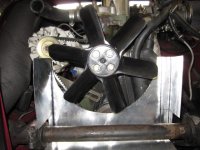DanLewis
Jedi Trainee
Offline
I recall reading an article on this issue where it was mentioned that when there isn't a full shroud the fan needs to be within an inch or so of the radiator. When it starts getting further away there is a tendency to draw air from the sides of the fan which then reduces what it will draw through the radiator since the air seems to flow easier from the sides since there's no restrictions. And since that flow from the sides isn't passing through the radiator, it's not capturing any heat from the coolant. With a full shroud it can be further back as long as it isn't outside the shroud.
Hi Mike! Those were my exact thoughts. Unfortunately, there's no way to get the fan within an inch of the radiator core, so the effectiveness of the shroud is crucial.
the cardboard stuff was not on a bugeye but a later model mg maybe a MGB even. Glad the shroud helped.
Oh, I assume you have the shroud that goes around the sides and over the top of the radiator and is attached to the radiator??
Just something you said, I bet it is missing.
Hi Jack! That would have explained my cooling problems for sure, but I do have a shroud on my radiator that covers the top and about 2/3rds the way down on both sides. It's the open space below the shroud that concerns me. Maybe I should go find an MGB to look at and see how the cardboard was used.
Dan

 Hi Guest!
Hi Guest!

 smilie in place of the real @
smilie in place of the real @
 Pretty Please - add it to our Events forum(s) and add to the calendar! >>
Pretty Please - add it to our Events forum(s) and add to the calendar! >> 


